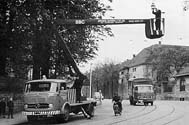Starting a Mercedes-Benz Ponton Engine
A supplement to the point gap page? A stand-alone page?
![]()



![]()
A supplement to the point gap page? A stand-alone page?
![]()



![]()
Three part test for no start situations: (this would fit well into the point gap page text)
Remove center distributor wire and hold near (engine's electrical) ground with insulated pliers. I keep a wooden clothespin handy for this. Any place on the block will do. Have someone crank the engine and look for a snapping spark. No or weak spark = ignition problem.
Remove distributor cap. Rotate engine by rolling car so that points close then are open again. Verify that they open and close. If not, adjust points, too large a gap is better than too small for a hard to start problem.
With cap off (immediately after step 2). Turn ignition on, and rotate engine again, just enough so that points close and then open again. Short the points with a screwdriver. If you get a spark now, the problem is the points.
From: "tontingan" <tontingan@yahoo.com>
Date: Fri Dec 19, 2003 1:45 pm
Subject: starting after long storage.
What are the steps to get a car started after a long storage (5 years). What do I need to do before I can start the engine?
From: "empires2000" <empires2000@yahoo.com>
Date: Fri Dec 19, 2003 4:02 pm
Subject: Re: starting after long storage.
I've had several cars that were stored outdoors for up to 3 years without starting. They all started right up as soon as the fuel pump primed the carburator(s), or in one case the fuel injection. One car must have had some rust on the valves because it ran rough for about 15 minutes, then cleared up completely and ran well with high compression on all cylinders.
Before starting I pulled all the spark plugs and cranked the engines until the oil pressure light/gauge registered pressure for 30 seconds or so. Based on the evidence that all the engines cranked over quickly and smoothly, I didn't worry about internal rust, although it might have been a slight problem in one car. The gas also burned just fine, even after up to 3 years.
You might want to take a look for rust inside the cylinders after pulling the plugs. Do this at night, with a flashlight, or you won't be able to see anything. I'd even hunt down an fiber optic flashlight if I were doing this today. If you find a lot of rust I guess it doesn't matter, since you're probably not pulling the head to clean all the cylinders. But you will spray a pretty liberal amount of penetrating oil into each cylinder and let it sit for a day, and maybe do it again the next day. Maybe the third day you'd squirt some engine oil...not a whole lot...into each cylinder and let it settle down to the rings for maybe an hour. You will also want to change the engine oil and filter. A lot of sludge in the crankcase could be a real problem, but other than dropping the oil pan there is not much you can do about this. Maybe change the oil and filter every day for 2 or 3 days after you get it started?
Then, with the plugs still out, make your move and crank the engine over until you see pressure on the oil gauge for 30 seconds. I would probably take the valve cover off and squirt oil all over the cams and bearings up top. It only takes a few minutes to do.
If the pistons are rusted tight you can probably shock them with the starter to get them moving. But if this happens the rings are probably corroded or seized into the piston lands and you are going to burn oil like crazy. Another trouble spot is the valve seals. They are going to be dried out after an extended period, and that's the optimistic scenario.
If you start the motor and by some miracle you have high compression and don't burn oil the rust and corrosion will just blow out the pipe within a few minutes.
Let us know how it goes. It's interesting getting an old car running again.
Good luck,
Robert